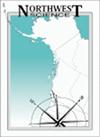爱达荷州哈里斯锥虫和索氏锥虫(鞘翅目:角虫科)种群动态、飞行期和挥发性信息素吸引力的比较
IF 0.5
4区 环境科学与生态学
Q4 ECOLOGY
引用次数: 2
摘要
信息素节约现象在长角甲虫(鞘翅目:天牛科)中普遍存在,它们共享许多高度保守的挥发性信息素基元。这种节俭反映了它们的生活史、生态和分布。在三年的时间里,我们在爱达荷州北部和南部的几个地点进行了实地生物测定,测试了天牛酰胺对12种挥发性信息素诱饵的吸引力。我们的总体目标是研究挥发性信息素在神经酰胺物种地理分布中的作用,在生殖隔离的神经酰胺群落内的相互作用,并确定可用于监测神经酰胺的诱饵的有吸引力的信息素。本研究的重点是角虫属(Prioninae亚科)。诱捕结果表明,在爱达荷州,哈里斯T. LeConte种群和soror T. Laplante种群之间存在区域分裂,在我们的站点中,两种种群数量较多的是爱达荷州北部的哈里斯T.和爱达荷州南部的soror T.。我们发现哈里氏T.和索尔氏T.的飞行周期是重叠的,这表明这两个物种并没有利用飞行周期来防止它们在爱达荷州种群之间的种间交叉吸引。我们的研究结果增加了对沙眼物种生态学的理解,以及信息素和飞行期物候在维持生殖隔离中的作用,并将有助于开发监测天虫的诱饵。本文章由计算机程序翻译,如有差异,请以英文原文为准。
Comparative Population Dynamics, Flight Periods, and Volatile Pheromone Attraction of Tragosoma harrisii and Tragosoma soror (Coleoptera: Cerambycidae) in Idaho
Abstract Pheromone parsimony is widespread within the longhorned beetles (Coleoptera: Cerambycidae), which share a number of highly conserved volatile pheromone motifs. This parsimony reflects their life histories, ecology, and distribution. We conducted field bioassays testing attraction of cerambycids to 12 volatile pheromone lures at sites in both northern and southern Idaho over a period of three years. Our overall goals were to investigate the role of volatile pheromones in the geographic distribution of cerambycid species, interactions within cerambycid communities in reproductive isolation, and to identify attractive pheromones that can be used to develop lures for monitoring cerambycids. This study focused on the genus Tragosoma (subfamily: Prioninae). Trapping results suggested a regional split between populations of T. harrisii LeConte and T. soror Laplante within Idaho, with the more abundant of the two species at our sites being T. harrisii in northern Idaho and T. soror in southern Idaho. We found the flight periods of T. harrisii and T. soror overlapped, suggesting that flight period is not being used by these two species as a mechanism to prevent inter-specific cross-attraction among their populations in Idaho. Our results increase understanding of the ecology of Tragosoma species, and the role of pheromones and flight period phenology in maintaining reproductive isolation, and will aid in development of lures for monitoring cerambycids.
求助全文
通过发布文献求助,成功后即可免费获取论文全文。
去求助
来源期刊

Northwest Science
环境科学-生态学
CiteScore
1.30
自引率
0.00%
发文量
23
审稿时长
>36 weeks
期刊介绍:
The pages of Northwest Science are open to original and fundamental research in the basic, applied, and social sciences. All submissions are refereed by at least two qualified peer reviewers. Papers are welcome from authors outside of the Pacific Northwest if the topic is suitable to our regional audience.
 求助内容:
求助内容: 应助结果提醒方式:
应助结果提醒方式:


